Situated in the very heart of the capital, Nelson’s Column, dedicated to Britain’s most beloved naval hero, is by far one of London’s most famous landmarks.
When it was first unveiled in 1843, the column wasn’t London’s only lofty monument to Admiral Lord Horatio Nelson. If you’d been around at the time and had ventured north towards Kentish Town, you would have discovered Nelson’s Tree…
The tall sycamore was said to have a direct link with Nelson who, as a 12 year old boy in early 1771, travelled from his native Norfolk to spend time with his uncle, William Suckling who lived at Grove Cottage, Kentish Town.
Whilst staying in what was then a very rural north London, Nelson is believed to have tended his uncle’s garden- which included planting the seed that would eventually blossom into the grand tree upon which his name would be bestowed.
Following his stint in Kentish Town, young Horatio headed further south to Sheerness in Kent, where he joined his other uncle, Captain Maurice Suckling, aboard HMS Triumph.
Being sent to sea was something the budding young Nelson had specifically requested he be allowed to do.
His uncle agreed to take him on as a servant, although he was slightly bemused- Horatio was a sickly child, and the captain expressed concern about his nephew being “sent to rough it out at sea.”
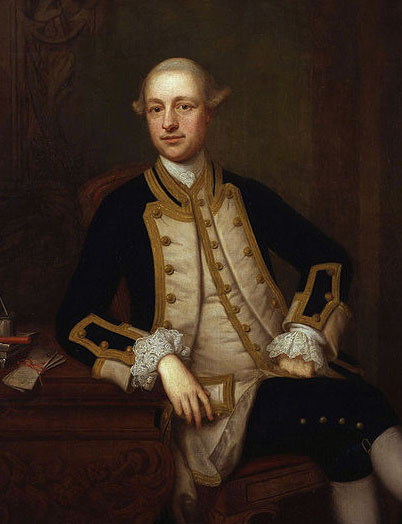
Captain Maurice Suckling; the uncle who introduced young Horatio to the Royal Navy (portrait by Thomas Bardwell).
In June 1846, (over forty years after the 1805 Battle of Trafalgar in which Nelson was famously killed), The London Illustrated News reported that the houses surrounding Nelson’s Tree are “to be shortly removed in the formation of a new street; but the Sycamore, we are assured, will be spared.”
Sadly, despite these assurances, no trace of the tree can be seen today (nor can I find details on when it was felled).
The article also stated that, “as a guide to visitors whom curiosity may lead to the locality, we may mention that the Tree stands close to the southern wall of the Castle Tavern.”
Kentish Town’s Castle Tavern was originally built in 1651- the image above represents how it would have appeared during Nelson’s time.
In 1848, the pub was rebuilt on the same spot.
In recent years, the former Castle has had a rather chequered history.
A few years ago, it was turned into a live music joint called the Bullet Club. When this attracted noise complaints, the venue was rebranded The Flowerpot Club… which closed in 2010.
Sadly, this historic building now appears to be in the process of demolition; no doubt a process which will result in the site being replaced with a block of outrageously priced apartments.
*
As mentioned earlier, the 1843 edition of the London Illustrated News mentioned that the now long-lost Nelson Tree could be found towards the southern wall of the Castle Tavern.
Today, this site is covered by another forgotten local relic… ‘Kentish Town South’; one of London Underground’s many abandoned ‘ghost stations.’
Originally planned under the name ‘Castle Road’, Kentish Town South opened in June 1907.
Sandwiched between Kentish Town and Camden Town stations, Kentish Town South suffered low passenger numbers from the off and closed in 1924 after just 17 years.
After being used as an air raid shelter in WWII, Kentish Town South’s street level building was converted into shop units- which are today home to a branch of Cash Converters.
Part of the station is retained as an emergency access and evacuation point and sharp eyed commuters can still spot the hollow, cavernous remains as they whoosh through below.
In 1951, and apparently inspired by a real life (although quickly resolved) incident, Sir John Betjeman penned a short story about the unfortunate ‘Mr Basil Green’, who made the grave mistake of alighting at the ghost station following a mistake by the tube guard…
The full text of this darkly humorous story, which was originally broadcast on the BBC Home Service and takes a gleeful dig at meddling civil servants, can be read below…
* * *
‘South Kentish Town’, by Sir John Betjeman (1951).
This is a story about a very unimportant station on the Underground railway in London.
It was devastatingly unimportant.
I remember it quite well. It was called ‘South Kentish Town‘ and its entrance was on the Kentish Town Road, a busy street full of shops.
Omnibuses and tramcars passed the entrance every minute, but they never stopped. True, there was a notice saying ‘STOP HERE IF REQUIRED‘ outside the station. But no one required, so nothing stopped.
Hardly anyone used the station at all. I should think about three people a day. Every other train on the Underground railway went through without stopping: “Passing South Kentish Town!”
Passengers used Camden Town Station to the south of it, and Kentish Town to the north of it, but South Kentish Town they regarded as an unnecessary interolation, like a comma in the wrong place in a sentence, or an uncalled-for remark in the middle of an interesting story.
When trains stopped at South Kentish Town the passengers were annoyed.
Poor South Kentish Town.
But we need not be very sorry for it.
It had its uses.
It was a rest-home for tired ticket-collectors who were also liftmen: in those days there were no moving stairways as they had not been invented.
“George,” the Station Master at Leicester Square would say, “You’ve been collecting a thousand tickets an hour here for the last six months. You can go and have a rest at South Kentish Town.” And gratefully George went.
Then progress came along, as, alas it so often does: and progress, as you know, means doing away with anything restful and useless.
There was an amalgamation of the Underground railways and progressive officials decided that South Kentish Town should be shut.
So the lifts were wheeled out of their gates and taken away by road in lorries. The great black shafts were boarded over at the top; as was the winding spiral staircase up from the Underground station. This staircase had been built in case the lifts went wrong – all old Underground stations have them.
The whole entrance part of the station was turned into shops. All you noticed as you rolled by in a tramcar down the Kentish Town Road was something that looked like an Underground station, but when you looked again it was two shops; a tobacconist’s and a coal-merchant’s.
Down below they switched off the lights on the platforms and in the passages leading to the lifts, and then they left the station to itself.
The only way you could know, if you were in an Underground train, that there had ever been a South Kentish Town Station, was that the train made a different noise as it rushed through the dark and empty platform. It went quieter with a sort of swoosh instead of a roar and if you looked out of the window you could see the lights of the carriages reflected in the white tiles of the station wall.
Well now comes the terrible story I have to tell.
You must imagine for a moment Mr Basil Green.
He was an income tax official who lived in N.6 which was what he called that part of London where he and Mrs Green had a house.
He worked in Whitehall from where he sent out letters asking for money (with threat of imprisonment if it was not paid).
Some of this money he kept himself, but most of it he gave to politicians to spend on progress.
Of course it was quite all right, Mr Green writing these threatening letters as people felt they ought to have them.
That is democracy.
Every weekday morning of his life Mr Green travelled from Kentish Town to the Strand reading the News Chronicle.
Every weekday evening of his life he travelled back from the Strand to Kentish Town reading the Evening Standard.
He always caught exactly the same train. He always wore exactly the same sort of black clothes and carried an umbrella. He did not smoke and only drank lime-juice or cocoa. He always sent out exactly the same letters to strangers, demanding money with threats.
He had been very pleased when they shut South Kentish Town Station because it shortened his journey home by one stop.
And the nice thing about Mr Basil Green was that he loved Mrs Green his wife and was always pleased to come back to her in their little house, where she had a nice hot meal ready for him.
Mr Basil Green was such a methodical man, always doing the same thing every day that he did not have to look up from his newspaper on the Underground journey. A sort of clock inside his head told him when he had reached the Strand in the morning. The same clock told him he had reached Kentish Town in the evening.
Then one Friday night two extraordinary things happened.
First there was a hitch on the line so that the train stopped in the tunnel exactly beside the deserted and empty platform of South Kentish Town Station.
Second, the man who worked the automatic doors of the Underground carriages pushed a button and opened them. I suppose he wanted to see what was wrong.
Anyhow, Mr Green, his eyes intent on the Evening Standard, got up from his seat.
The clock in his head said ‘First stop after Camden Town, Kentish Town.’
Still reading the Evening Standard he got up and stepped out of the open door on to what he thought was going to be Kentish Town platform, without looking about him.
And before anyone could call Mr Green back, the man at the other end of the train who worked the automatic doors, shut them and the train moved on. Mr Green found himself standing on a totally dark platform, ALONE.
“My hat!” said Mr Green, “wrong station. No lights? Where am I? This must be South Kentish Town. Lordy! I must stop the next train. I’ll be at least three minutes late!”
So there in the darkness he waited.
Presently he heard the rumble of an oncoming train, so he put his newspaper into his pocket, straightened himself up and waved his umbrella up and down in front of the train.
The train whooshed past without taking any notice and disappeared into the tunnel towards Kentish Town with a diminishing roar.
“I know,” thought Mr Green, “my umbrella’s black so the driver could not see it. Next time I’ll wave my Evening Standard. It’s white and he’ll see that.”
The next train came along. He waved the newspaper, but nothing happened.
What was he to do? Six minutes late now. Mrs Green would be getting worried.
So he decided to cross through the dark tunnel to the other platform. “They may be less in a hurry over there”, he thought.
But he tried to stop two trains and still no one would take any notice of him.
“Quite half an hour late now! Oh dear, this is awful. I know – there must be a staircase out of this empty station. I wish I had a torch. I wish I smoked and had a box of matches. As it is I will have to feel my way.”
So carefully he walked along until the light of a passing train showed him an opening off the platform.
In utter darkness he mounted some stairs and, feeling along the shiny tiled walls of the passage at the top of the short flight, came to the spiral staircase of the old emergency exit of South Kentish Town Station.
Up and up he climbed; up and up and round and round for 294 steps.
Then he hit his head with a terrific whack.
He had bumped it against the floor of one of the shops, and through the boards he could hear the roar of traffic on the Kentish Town Road. Oh how he wished he were out of all this darkness and up in the friendly noisy street.
But there seemed to be nobody in the shop above, which was natural as it was the coal-merchant’s and there wasn’t any coal.
He banged at the floorboards with his umbrella with all his might, but he banged in vain, so there was nothing for it but to climb all the way down those 294 steps again.
And when he reached the bottom Mr Green heard the trains roaring through the dark station and he felt hopeless.
He decided next to explore the lift shafts.
Soon he found them, and there at the top, as though from the bottom of a deep, deep well, was a tiny chink of light. It was shining through the floorboards of the tobacconist’s shop.
But how was he to reach it?
I don’t know whether you know what the lift shafts of London’s Underground railways are like. They are enormous – twice as big as this room where I am sitting and round instead of square.
All the way round them are iron ledges jutting out about six inches from the iron walls and each ledge is about two feet above the next. A brave man could swing himself on to one of these and climb up hand over hand, if he were sensible enough not to look down and make himself giddy.
By now Mr Basil Green was desperate. He must get home to dear Mrs Green.
That ray of light in the floorboards away up at the top of the shaft was his chance of attracting attention and getting home. So deliberately and calmly he laid down his evening paper and his umbrella at the entrance to the shaft and swung himself on to the bottom ledge.
And slowly he began to climb.
As he went higher and higher, the rumble of the trains passing through the station hundreds of feet below grew fainter.
He thought he heard once again the friendly noise of traffic up in the Kentish Town Road. Yes, he did hear it, for the shop door was, presumably, open.
He heard it distinctly and there was the light clear enough. He was nearly there, nearly at the top, but not quite. For just as he was about to knock the floorboard with his knuckles while he held desperately on to the iron ledge with his other hand there was a click and the light went out.
Feet above his head trod away from him and a door banged. The noise of the traffic was deadened, and far, far away below him he caught the rumble, now loud and now disappearing, of the distant, heedless trains.
I will not pain you with a description of how Mr Green climbed very slowly down the lift shaft again. You will know how much harder it is to climb down anything than it is to climb up it. All I will tell you is that when he eventually arrived at the bottom, two hours later, he was wet with sweat and he had been sweating as much with fright as with exertion.
And when he did get to the bottom, Mr Green felt for his umbrella and his Evening Standard and crawled slowly to the station where he lay down on the dark empty platform.
The trains rushed through to Kentish Town as he made a pillow for his head from the newspaper and placed his umbrella by his side.
He cried a little with relief that he was at any rate still alive, but mostly with sorrow for thinking of how terribly worried Mrs Green would be. The meal would be cold. She would be thinking he was killed and ringing up the police.
“Oh Violette!” he sobbed, “Violette!” he pronounced her name ‘Veeohlet’ because it was a French name though Mrs Green was English. “Oh Violette! Shall I ever see you again?”
It was now about half past ten at night and the trains were getting fewer and fewer and the empty station seemed emptier and darker so that he almost welcomed the oncoming rumble of those cruel trains which still rushed past. They were at any rate kinder than the dreadful silence in the station when they had gone away and he could imagine huge hairy spiders or reptiles in the dark passages by which he had so vainly tried to make his escape …
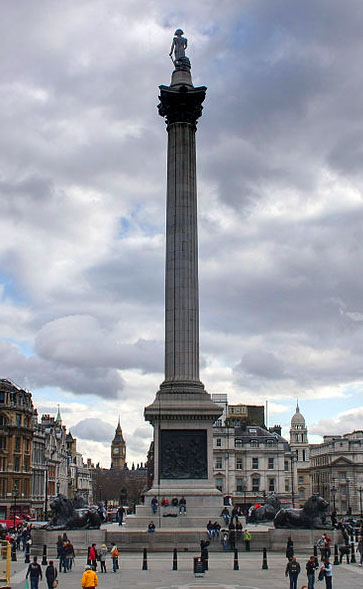















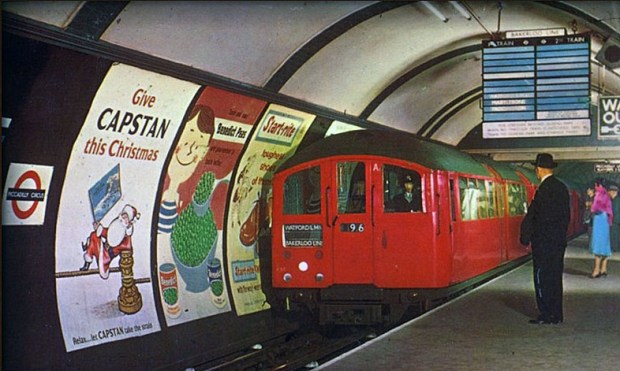












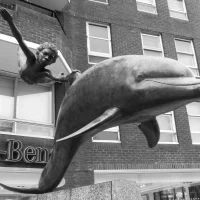



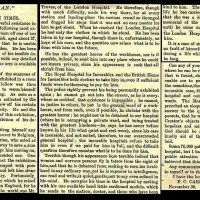




Great post – enjoyed reading it. As a side note of interest, if you like Nelson’s history I wrote a post about all his related sights in the Merton area of London -http://londonunveiled.com/2013/03/02/nelson-trail/ All the best, Ian
Thanks, Ian great post 🙂
[…] The other monument to Nelson, which once stood on the site of a ghost tube station. Fascinating stuff. […]
Fantastic! I was terrified of the underground as a child and the thought of getting stranded at a ghost station still terrifies me quite literally. So what happened to Mr Green? Was that the end? Is he still there?
Thanks, Damian 🙂 The story is open ended leaving the reader to decide for themselves.. I like to think he’d wait for the electric current to be switched off when the trains stop in the early hours…then walk along the rails!
I have a book which is a collection of fictitious tales relating to railways called Railway Ghosts by J A Brooks.
The last story in it is South Kentish Town. In this book however Mr Basil Green’s ordeal continues.
Allow me to finish the story.
…But all bad things come to an end. After a time there were no more trains. Then, I suppose, the electric current on the line was switched off, though Mr Green did not know this. And presently there were lights in the tunnel and approaching figures carrying hand-lamps.
Then a murmur of voices, then the figure of a big man in a boiler-suit, then another. They were the night staff of the railway repairing the lines and testing them ready for the next morning.
“Look ‘ere Bill” said the first man, lifting up his lamp, “there’s a bloke there
a-layin’ on the platform. What’s ‘e think “e’s a doing of?
“Silly jigger” said the other; “Got out ‘ere I suppose.”
“‘Ere mate! What yer doin’ ‘ere? You’re trespassing you know. This station’s been closed for twelve years.
“I know that,” said Mr Green and he told the men his story. The were sorry for him and they led him up the tunnel to Kentish Town Station. And when he got there, Mr Green, tired as he was, and without even accepting the cup of tea the men offered him, ran up the spiral stairs to the station entrance and went straight to a telephone box.
“Mountview 6686 – Violette! Violette – Oh darling Violette! It’s you. This is Basil. Yes. I’m all right. I’ll tell you what happened. Oh yes, I am all right. I’ll have to walk. Too late for any trains. I was caught in the Underground. I’ll tell you all about it when I get home. Expect me in a quarter of an hour. I’ll run all the way”
Oh how pleased she was to see him! And how pleased he was to see her! And after that they loved each other more than ever, for it’s God’s truth that real love like theirs was, is only strengthened by suffering.
Here is a great site on London’s abandoned underground stations. Looking forward to the next story, as always. http://underground-history.co.uk/front.php
Thanks, Sam. Excellent link.
I’d heard about that story before, but had not read the poem before. I’m a bit of a Betjeman fan, so thanks for that 🙂 By the way, that Holloway Road photo, it’s of the construction of the aborted spiral escalator. When the escalators started to replace the lifts, at stations where they couldn’t excavate an escalator shaft, they were going to replace the lift with a spiral escalator. But the test one fitted into Holloway Road never worked properly, so the plan was abandoned. There’s no record of the schematics for the mechanism and only a small section of the escalator was kept, the rest having been scrapped. Spiral escalators have been developed, though really, they’re just curved ones. They have them in the JC Penney in San Francisco, claiming to be the World’s first, but we got there first 100 years earlier 🙂
Thanks, Darren 🙂 Interesting info on the San Francisco escalator. Caledonian Road tube station was supposed to have a spiral too, you can see the abandoned shaft opposite the lifts.